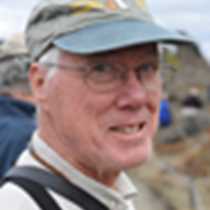Lillihookfjord, West Spitsbergen, Svalbard
Whales before breakfast! Last night we left Longyearbyen in Isfjord, and turned northward to follow the west coast of the large island of Spitsbergen. This is the ice-free side of the Svalbard archipelago, kept free of ice by the relatively warm, north-flowing West Spitsbergen current. Large whales often gather to feed where the shallow water of the continental shelf drops off to the much deeper water of the abyss. Here, ocean currents bring nutrients to the surface, making this an area of high productivity. Sure enough—there they were, tall columns of vaporized water marking each exhalation as the whales rose to breathe. We were surrounded by feeding fin whales, the second largest (after only blue whales) of all mammals, of all animals. Several whales were synchronizing their feeding/breathing cycles—up together for four or five breaths to renew the oxygen in their tissues, then diving for some minutes in search of their prey. It was a very fine beginning to our trip.
We turned into Crossfjord and then its western arm, Lillehookfjord. There we found the tiny, protected harbor of Signehamn. Here, out of sight from the sea, the Germans established a weather station in WWII. Information about the weather in the north was important to both sides in predicting conditions along the seaway bringing convoys of supplies to the Eastern front, via North Cape to Murmansk. The remains of the station provided a destination for some of our walks over the moss and lichen dominated tundra, while longer walkers continued around an ice-covered lake. Several Svalbard reindeer made an appearance as cameras clicked. Their antlers, shed annually, are now growing rapidly and their fur is changing from winter white to summer brown. They must accomplish this and fatten as well in the short Arctic summer, for they depend on fat accumulated in summer to make it through the long, dark, cold winter to come.
Across the fjord from Signehamn is the Lillihookbreen glacier. We returned to the National Geographic Explorer and approached the glacier, using our ship as a viewing platform. The water soon became clogged with small pieces of ice called brash ice and larger icebergs, up to the size of a house, all dropped into the sea from the face of this tidewater glacier. The overcast sky seemed to intensify the incredible blue color of the larger icebergs and the glacier face, seen against the dark mountains beyond. Floating ice was used as resting platforms by bearded seals. These are large seals of up to 700 or so lbs, each with a head that is seemingly several sizes too small. They use their fine "beards" of vibrissae (OK - whiskers) to find food, especially benthic invertebrate animals, in the bottom of the fjord. In the process of feeding, their heads may acquire a rich red/orange stain from iron oxide in the sediments. We slowly approached. The seals were reluctant to leave their comfortable platforms, giving us great views, and then we backed off to leave them undisturbed on their ice. That is as it should be.




